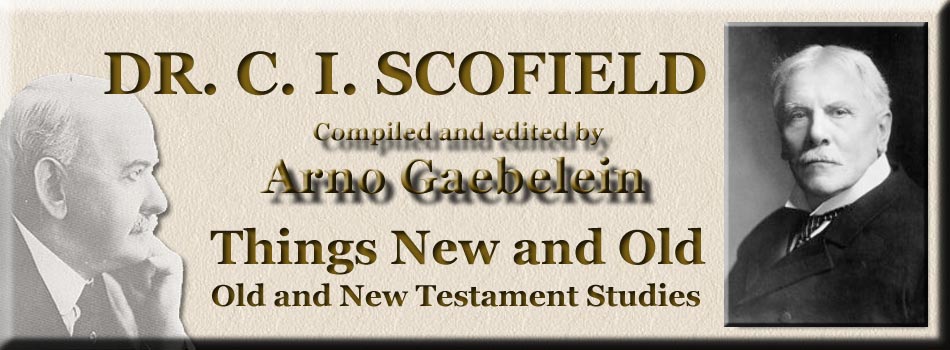
Things New and Old
By Cyrus Ingerson Scofield
Compiled and Edited By Arno Clement Gaebelein
HIS FIRST DISCIPLES.(John i: 35-51.) I. The Analysis. 1. The Very First Disciples (verses 36-39).—They heard a true testimony; they followed; they abode. 2. The First ''Finder'' (verses 40-42).—The man who had heard, followed, and abode, quite naturally ran to tell. Have you complied with the three conditions? We do not know that Andrew became a great preacher, but that day he brought a great preacher to Jesus. 3. The Great ''Finder" at Work (verse 43).—You are going to meet many a soul in heaven whose testimony will be, "No man cared for my soul, save the Man of Calvary only." Philip, the Jew with the Gentile name, seems to have been a pretty dull disciple (John xiv: 8, 9); perhaps no one but Jesus would have thought him worth finding. 3. The Third "Finder"' (verses 44-46).—Note his simple but sublime testimony: "We have found HIM." Philip could not answer Nathaniel's hard question, but he could suggest a good way out: "Come and see." 4. The New Testimony to Christ (verses 47-49).—John had already witnessed to Jesus as the Son of God; Nathaniel adds, as an instructed Jew who knew the Davidic covenant (2 Sam. vii: 8-i6), "the King of Israel." 5. The Promise of Greater Things (verses 50, 51). II. The Heart of the Lesson. We have, first, a precious lesson in Christian service. It began that day by Jordan in a certain specific testimony, "Behold the Lamb of God!" Did you ever notice that John the Baptist never explains his messages? That day, so significant as the day which saw the first disciples gathered to Christ, John did not explain what he meant by calling Christ "the Lamb of God." Every Jew knew that he was pointing to Jesus as the fulfiller of the sacrificial types— knew that every lamb sacrificed from the first Passover till that day pointed forward to a coming One. The application is obvious: the first secret of successful service is to point to Christ as the Sacrifice, the sin-bearer, the atonement maker. All true knowledge of Christ begins at the cross. Afterward we may go back to the cradle, and follow the sinless feet, and contemplate the great example. And the second lesson in successful service is that only one who has been with Jesus can win men to Him. One may be saved and yet know but little of the blessedness of communion with Christ. Personal faith is commonly the result of the testimony of another. John bore witness to Christ as the Lamb of God, and John and Andrew followed Him. But more: they ''abode with Him." Belief made them disciples, abiding made them soul seekers, and soul winners. The third lesson in service is that it should begin with what is nearest. Andrew went after his own brother, Simon. Too many people whose hearts begin to be stirred toward service, quiet their aroused consciences with great plans of of what they will do when they are somewhere else. Mr. Moody used to tell his boys and girls at Mount Hermon and Northfield that one who could do no service right where they might happen to be, would not do service anywhere. And note that Andrew was not satisfied with telling his brother about Jesus. He ''brought him to Jesus." The fourth lesson is that Jesus Himself is actively at work with His servants. It was Jesus who found Philip. The Lord is constantly making converts. Many a saint in glory owes his conversion to no human agency. A Bible, a sincere reader of the Bible, the risen Christ, and the Holy Spirit—these are enough. Underneath the last seven verses of the lesson is a wonderful dispensational picture upon which there is no room to dwell. It is prophetic of the future conversion of the Jewish remnant in the last days, and of the national conversion of Israel after our Lord's return.
|
|
 |
 |
|
|
|
-
Site Navigation
 Home
Home What's New
What's New Bible
Bible Photos
Photos Hiking
Hiking E-Books
E-Books Genealogy
Genealogy Profile
Free Plug-ins You May Need
Profile
Free Plug-ins You May Need
 Get Java
Get Java.png) Get Flash
Get Flash Get 7-Zip
Get 7-Zip Get Acrobat Reader
Get Acrobat Reader Get TheWORD
Get TheWORD